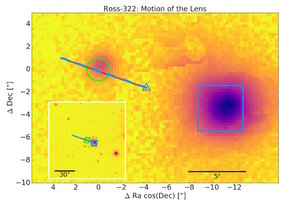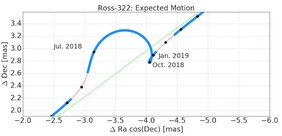Using data from Gaia astrometry satellite, astronomers at Heidelberg University investigated the movement of millions of stars in the Milky Way galaxy. For the first time, they were able to predict the approach of two stars with extreme precision and to forecast characteristic effects of relativistic light deflection that can be used to precisely measure the mass of stars. The findings were published in the journal “Astronomy & Astrophysics Letters”.
“The stars in the Milky Way don’t stand still, but move relative to one another like gnats in a swarm. As seen from Earth, a foreground star occasionally passes close to a background star. Light travelling towards us from the background star is shifted ever so slightly by the gravitational field of the foreground star as it passes,” explains Prof. Dr Joachim Wambsganß, Director at the Institute of Astronomical Computing at Heidelberg University's Centre for Astronomy (ZAH). This “astrometrical gravitational lensing” changes the position of the background star in the heavens by a very small but still measurable amount. This shift plus the relative position of the two approaching stars can be used to derive the mass of the foreground star.
“This method of measuring mass is precise to within a few percentage points. Until now, however, it has been very difficult to predict when and which star pairs would pass close enough to one another to support such measurements, because the stars' precise ‘proper’ motion in the sky must be known,” emphasises Prof. Wambsganß. The Gaia astrometry satellite has been measuring the position and the proper motion of approximately 1.5 billion stars for about four years, and its recently released data are of sufficient precision. The extensive dataset was published in April of this year.
Jonas Klüter, a doctoral student working with Prof. Wambsganß, combed through this vast data volume for the best star-crossings observable within the next 50 years, the period that can support reliable predictions using Gaia. The exhaustive analysis identified nearly 70.000 candidates, although not all are expected to produce a measurable shift. The researchers were able to predict a currently measurable effect for two stars currently located near a background star.
They are known as Luyten 143-23 and Ross 322 in the star catalogue and move across the celestial sphere at a speed of 1,600 and 1,400 milliarcseconds (mas), respectively. According to Jonas Klüter, one of the stars passed closest to the background star in early July this year; the other will do so in early August. Gravitational lensing shifts the position of the background stars by 1.7 and 0.8 mas, respectively.
Only the best telescopes can measure this change from Earth. Jonas Klüter is therefore conducting an observational campaign using, among others, the telescopes of the European Southern Observatory (ESO) in Chile. Aided by the telescopes, he will track the approaching star pairs and measure the positional shift to identify for the first time the mass of two stars by means of gravitational lensing.
Original Publication
J. Klüter, U. Bastian, M. Demleitner, J. Wambsganss: Ongoing astrometric microlensing events of two nearby stars, Astronomy & Astrophysics Letters, doi <link https: www.aanda.org articles aa abs aa33461-18 aa33461-18.html>10.1051/0004-6361/201833461
Further related information
<link https: www.uni-heidelberg.de presse news2018 pm20180725_how-to-weigh-stars-with-gravitational-lensing.html external-link-new-window internal link in current>Press Release of Heidelberg University
Contact
Dr. Guido Thimm
Zentrum für Astronomie der Universität Heidelberg (ZAH)
Public Outreach
Phone +49 6221 54-1805
thimm@ari.uni-heidelberg.de


